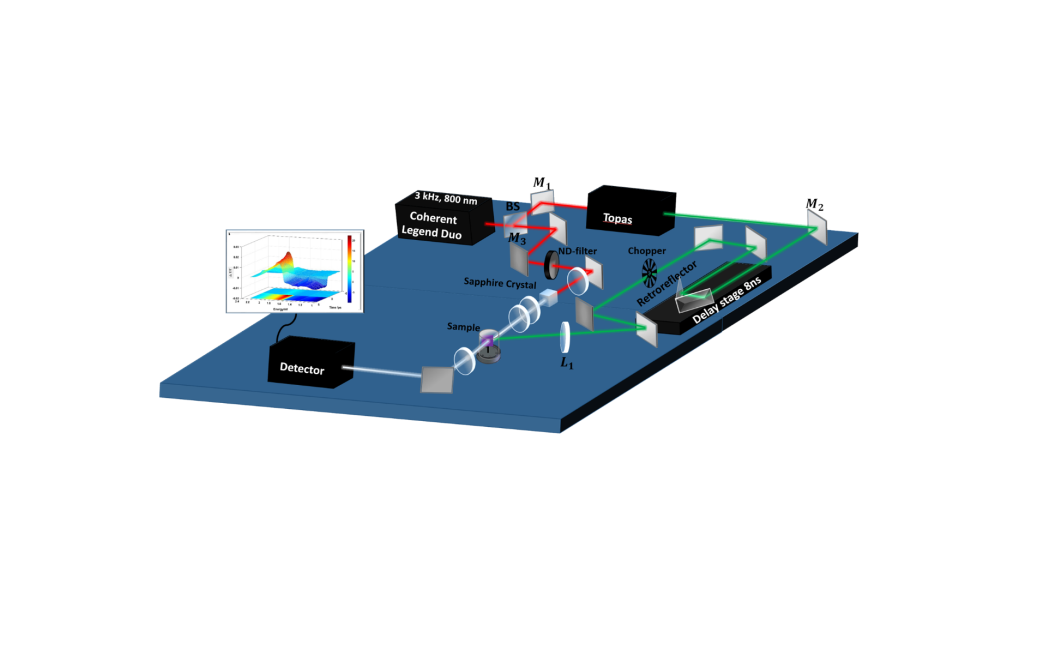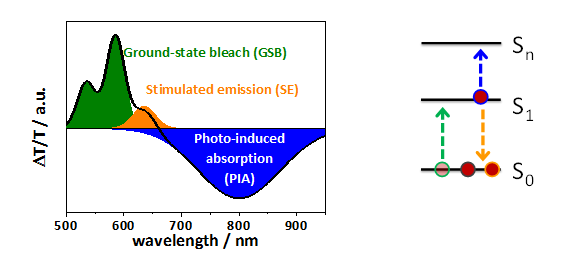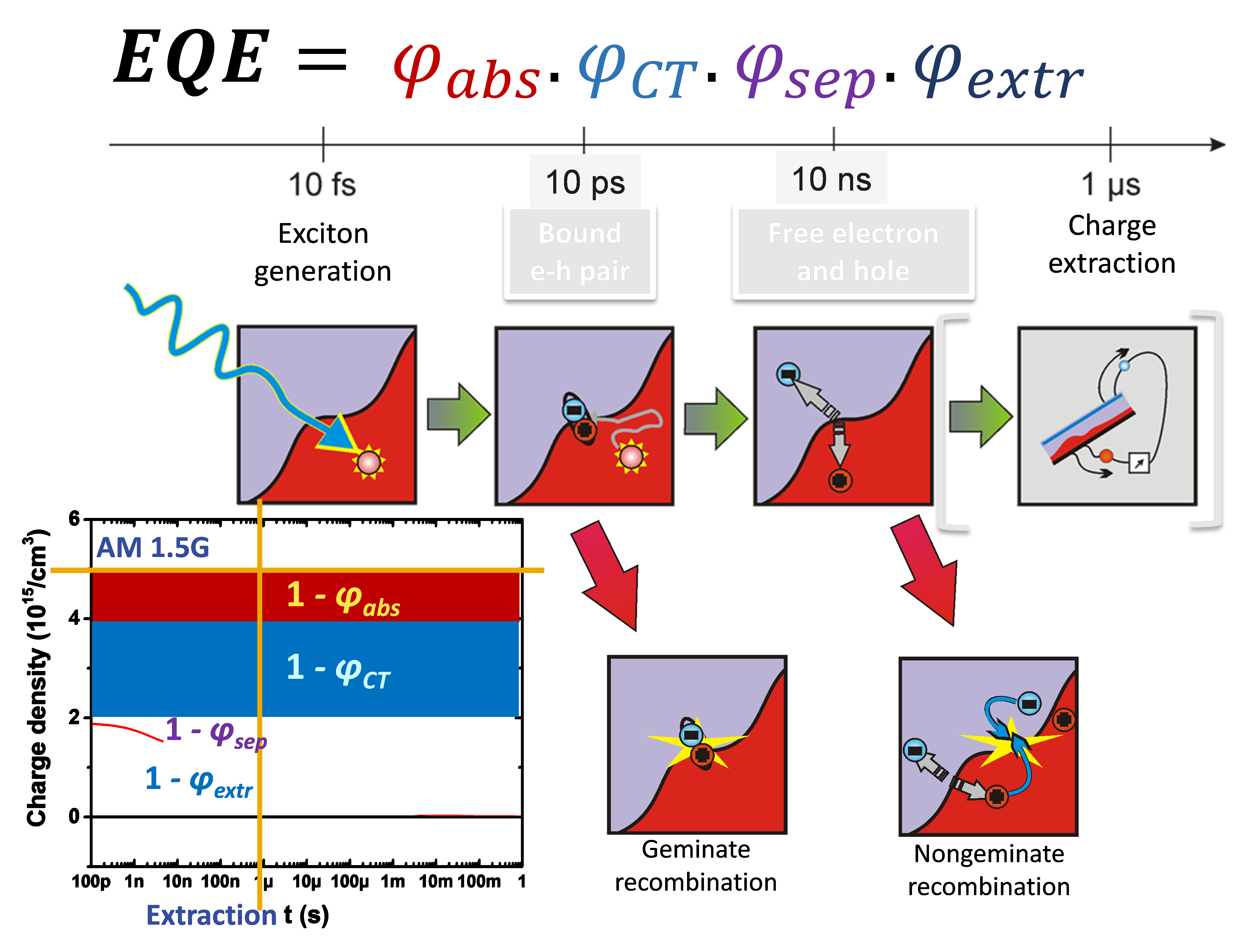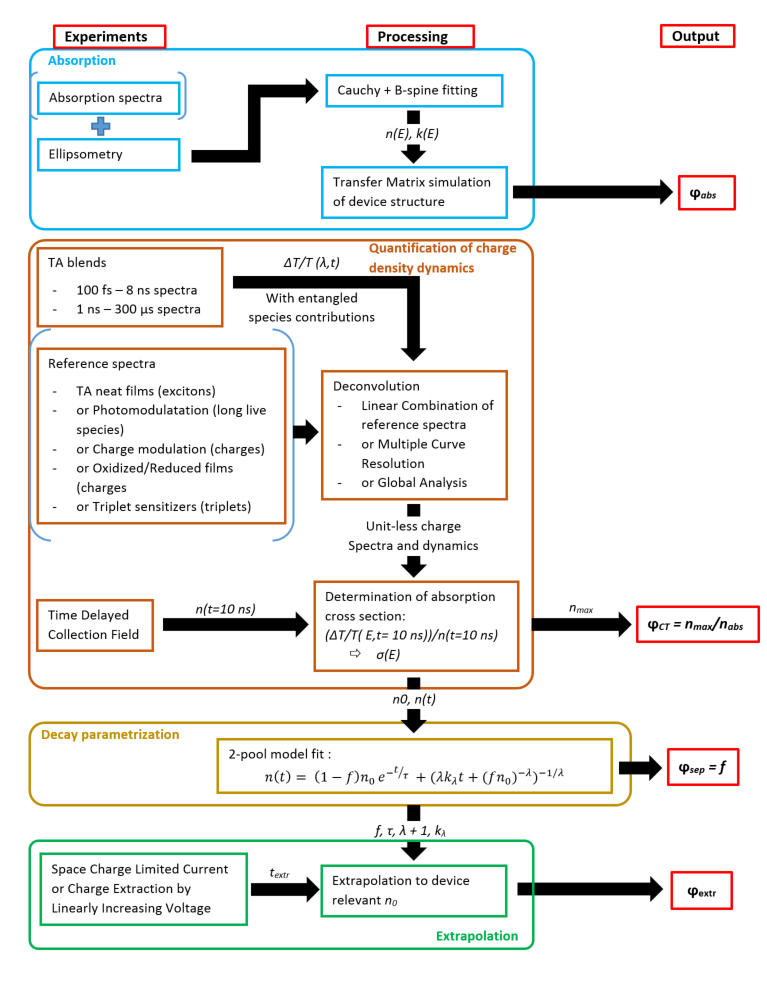
Transient absorption (TA) pump-probe spectroscopy is a powerful tool to monitor the dynamics of photo-excited states in soft and hard matter. Excited states are probed by monitoring their specific absorption, a method that causes only very limited
perturbation of the system compared to, for instance, chemical or electrical characterization.
TA is a differential pulse technique. A short pulse of white light is transmitted through a photoexcited sample and the transmission of the white
light is compared to that of a white light pulse transmitted through a non-excited sample (i.e. in the ground state). The difference between the spectra yields the excited state absorption, additional transmission, or stimulated emission) caused
by the presence of photoexcited states.

The time resolution is achieved by using a pulsed photo-excitation (pump pulse) and delaying the white light probe pulse by a delay time td between the two pulses. The probe pulse thus gives a snapshot of the system at the delay time td following photoexcitation. By varying td the dynamics of excited states in the material can be followed.
We use different techniques to generate pump-probe delays across a wide dynamic range:
Thus, overall we can cover a timerange from about 20fs to several hundred microseconds with our setup.
5905746e508449ce967daf2d7a4b00a8.png?sfvrsn=25f4cd98_1)
Figure 1: Transient absorption spectroscopy setup (ps - ns timerange configuration).
Excitation range:
Probe range: different sets of detectors (Si, InGaAs) and crystals for white light generation (sapphire, YAG, YVO4, and CaF2) allow us to generate white light from 360 nm to 2100 nm.
Soft matter studies: The ‘flexibility’ of interatomic bounds (covalent for intramolecular, Van der Waals or Ionic for intermolecular) of organic materials implies that any change of the electronic state of the material (excitation, ionization)
will affect the molecule itself and surrounding, that is, the energetic landscape will respond in a specific way. As a result, the absorption of an excited material strongly differs from that of the ground state, thus allowing to monitor the evolution
of the molecule after photoexcitation. Additionally, different excited states such as excitons, charges, triplet excitons, exhibit distinct spectral signatures, that allow to monitor them individually.
In the specific case of organic semiconductors,
electronic transitions of excited states are typically strong in the visible to near-infrared region. This the spectral region covered by the TA technique.
The study of photoexcited states in semiconductors is highly relevant for their application
in solar cells. In fact, it allows to detect the entire manifold of excited states generated upon light absorption in a photoactive material. Furthermore, the processing conditions and materials that maximize the generation of a certain state
(mobile charges) with respect to others (bound charges, triplets) as well as their ability to be transported across the active layer to be extracted from the device, can be studied.
However, applications are not limited to (organic) photovoltaics
only. TA is a technique that can be used to study many photoinduced energy conversion and charge transfer processes in soft and hard matter including photosynthetic systems, photocatalytic applications, and photochemical processes.

Figure 2: Electronic transitions underlying the different spectral features observed in transient absorption spectroscopy.

can be extracted transient absorption measurements. In parallel to these processes, others such as energy transfer (neutral excitation transfer from on material to another) or triplet excitons formation. To one exception, excited species are differentiated by their absorption spectra. However bound electron– hole pairs and free charges generally share the same spectra but differ by their kinetics. (Note that TA is typically measured on a film, not a device, extraction can thus not be directly monitored).
A typical dataflow for TAS experiment would be:

Figure 4: Simplified flowchart indicating the determination of the charge transfer ϕCT, charge separation ϕsep, and charge extraction ϕextr yields. n(t) represents the time-dependent charge density, f the fraction of separated charges, τ the lifetime of bound charge pairs, and kλ the coefficient of the empirical nongeminate recombination coefficient of apparent order λ + 1. Source: J. Gorenflot, A. Paulke, F. Piersimoni, J. Wolf, Z. Kan, F. Cruciani, A. El Labban, D. Neher, P. M. Beaujuge, F. Laquai, Adv. Energy Mater. 2017, 1701678. https://doi.org/10.1002/aenm.201701678.
